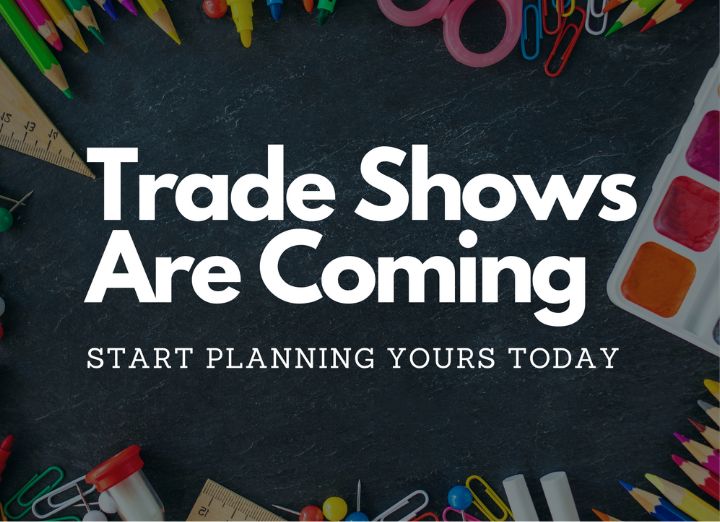Exhibiting at trade shows is an intricate endeavor that demands considerable time, effort, and strategic finesse. The flurry of deadlines can lead to unexpected expenses if not met, underscoring the need for a meticulously designed timeline that guides the booth display process. Constructing a timeline requires an upfront investment of your resources, but the rewards of streamlined execution and successful outcomes make it an important endeavor for a successful trade show.
Continue reading for a comprehensive trade show planning timeline that delineates the key stages and their respective timeframes to take the stress out of trade show planning and execution. By adhering to this roadmap, you can navigate the complexities of trade show marketing confidently and efficiently, ensuring that every facet of your trade show display is meticulously planned and executed.
Logistics Management: The Role of Event Organizers
Logistics is a major component in trade show planning. Event planning ensures the smooth operation of exhibition installation, registrations, and crowd management. It also leaves space for unexpected problems like technical or staff difficulties.
What is a trade show planner? Trade show planners are event organizers who manage industry-specific exhibitions where businesses gather to promote their products and services. Using the trade show marketing plan as a guide, event planners develop booth schedules, identify needed marketing materials, secure sponsors and vendors and maintain the smooth functioning of the show.
Key Trade Show Planning Challenges Faced by Event Organizers
Guaranteeing your event’s success is a multifaceted challenge that demands meticulous attention to detail and coordination. The first critical hurdle lies in venue selection. The choice of venue profoundly influences the event’s overall ambiance and logistics. It’s essential to identify a space with a floor plan that accommodates the anticipated number of exhibitors and attendees while offering the necessary exhibitor resources. Budget management is another intricate task, as attending trade shows often require significant financial resources. Careful allocation of funds, accurate cost projections, and vigilant expense tracking are paramount to executing a successful trade show event without surpassing financial limits.
Effective communication emerges as a central challenge in trade show planning. Coordinating numerous stakeholders, such as exhibitors, attendees, suppliers, and your sales team, demands a streamlined communication strategy. Miscommunications can lead to misunderstandings and logistical hiccups, underscoring the need for crystal-clear communication channels. Establishing pre-show marketing initiatives is an equally demanding task. Generating excitement and interest to reach prospects necessitates a compelling sales message and a well-crafted marketing strategy that spans diverse channels—both online and at show marketing in your display booth and the event space at large.
Review Your Trade Show Exhibit Requirements in Detail
Your key to a winning trade show exhibit is to review every facet of the exhibit space requirements. From your booth space, booth accessories, literature and marketing materials, promotional items to staffing and logistical arrangements, a comprehensive evaluation of your booth space needs ensures that no detail goes unnoticed. This step is your compass for crafting an exhibit that meets and exceeds your objectives, leaving a lasting impression on attendees.
12 Months Prior: Laying the Foundation
Reflecting on past trade show experiences unveils effective strategies and learning from setbacks. If prior experience is available to you, this retrospection can inform fresh objectives for your next round of trade show planning. This stage involves the meticulous selection of a trade show that aligns with your company’s overarching goals, a decision of strategic significance. Moreover, financial prudence takes center stage as you craft a budget encompassing various aspects of the ultimate trade show marketing plan, ensuring that your exhibit vision remains both ambitious and pragmatic.
- Begin by scrutinizing your past trade show planning experiences to discern what strategies proved effective and what fell short of expectations.
- Establish fresh objectives derived from the lessons learned from past show outcomes.
- Cautiously elect the trade show that would optimally align with your company’s goals for the exhibition. For example, is your objective general brand recognition or targeted lead generation?
- Devise a reasonable budget for the entire event, factoring in costs for various aspects including less obvious considerations like early bird discounts and follow up packets that may bookend the event.
9–12 Months Prior: Setting Clear Aims for your Trade Show
This phase extends its reach beyond abstract goals, delving into the tangible elements that constitute your exhibit’s essence. With precision, you delineate the framework, encompassing not only the physical exhibit structure but also the strategic deployment of promotional strategies and other marketing collateral materials, infusion of technological innovations, and the artistic rendition of visual graphics.
- Revisit and solidify specific goals, objectives, and intended outcomes for participating in the upcoming trade show such as lead generation. This phase involves defining the essentials for your exhibit, encompassing the exhibit structure itself, promotional materials, technological components, and the visual graphics used in your exhibit design.
- For those new to trade show participation, leverage the expertise of Apple Rock’s experienced staff to decipher your requirements. They can provide invaluable assistance to:
- Secure suitable exhibition space.
- Initiate the exhibit design process.
- Acquire comprehensive exhibitor guidelines from show management.
- In parallel, when outlining your marketing strategy, contemplate your target audience, methods to engage the general public about your exhibit, planned attendee interactions, and your post-show follow-up scheme.
6–9 Months Prior: Initiating the Trade Show Process
The overarching goal is to lay the groundwork for your trade show exhibit’s identity and communication strategy. This phase is about establishing a cohesive display booth identity, crafting communication methods to increase brand awareness, and enhancing attendee engagement through thoughtful choices in promotional methods.
- Collaborate with your chosen design partner to craft the desired visual identity and ambiance for your booth. Consistency and clarity in branding are pivotal. Your designers can be instrumental in this endeavor, provided you convey your needs, preferences, and expectations effectively.
- Define your requirements for promotional materials or interactive technologies. Whether opting for conventional printed materials or cutting-edge interactive solutions, determining the most compelling medium to convey your message is paramount.
- Explore potential promotional items that can leave a lasting impression and effectively distinguish your booth from the crowd.
3–6 Months Prior: Attending to the Trade Show Details
It is time to put your trade show marketing plans into action by addressing the practical intricacies. This phase of sales strategy is all about executing your preparations to create a well-organized and impactful trade show presence at the next event.
- Procure promotional items that align with your branding and event theme.
- Finalize and order your collateral materials, ensuring that any interactive technology is loaded with essential literature, product imagery, information, and videos intended for display.
- Architect a comprehensive staffing plan, complete with a staffing schedule for your booth. This is the juncture to decide whether additional personnel need to be recruited to optimize your presence.
- Arrange for essential show services such as shipping, drayage, electrical arrangements, and cleaning. Mind the deadlines for advance discounts.
1–3 Months Prior: Intensify Marketing Efforts
The primary focus shifts to amplifying your outreach efforts to maximize the impact of your upcoming trade show participation. Simultaneously, you’re in the process of organizing travel arrangements for your team members who will be representing your company at the event. This ensures their seamless attendance and readiness to engage with attendees. You’re also reaching out to vendors, potential clients, and existing customers who are expected to be present at the same trade show together.
In essence, this phase is about maximizing your presence through strategic marketing, through training sessions ensuring team readiness, and proactively engaging with stakeholders for a positive trade show experience.
- Commence pre-show marketing endeavors, encompassing strategies like direct mail campaigns, social media engagement, and public relations initiatives.
- Begin making travel arrangements for your team members who will be attending the event.
- Reach out to vendors, potential clients, and existing customers who are anticipated to attend the show. Set up appointments, dinners, or meetings to maximize networking opportunities.
1–3 Weeks Prior: The Final Push
This pivotal stage embodies a meticulous and purposeful approach to ensure every detail is in place for a successful exhibit. Here, the importance of comprehensive planning timeline oversight comes to the forefront as you diligently review and confirm all arrangements, leaving no space for oversight or uncertainty. This proactive step sets the stage for a seamless setup, sparing no effort to ensure that the very detailed trade show booth design and space’s physical elements are primed to captivate and engage attendees.
- Undertake a meticulous review and confirmation of all arrangements, leaving no room for oversight.
- Verify the safe arrival of your exhibit, graphics, and all essential supplies at the designated venue.
- Devise a robust post-show follow-up strategy to capitalize on the connections and insights garnered during the event.
In the world of trade shows, a well-executed timeline is the key to transforming the complex challenges of planning and executing an exhibit into a streamlined and successful venture. Our comprehensive guide provides a roadmap, outlining crucial stages and timeframes that guide you through the process. From setting clear aims and attending to practical details to orchestrating the final preparations for your trade show display, this timeline ensures a cohesive and impactful trade show presence.
By adhering to this timeline, you not only alleviate last-minute stress but also maximize your potential for meaningful interactions with your target audience, successful networking, and brand visibility. Trade show success demands meticulous planning, and a well-crafted timeline is your essential tool to navigate the intricacies, ultimately leading to a rewarding and memorable experience that resonates long after the trade show event ends.






